

Rodent Proofing
Your satisfaction is our #1 Priority
Rodent Proofing you can trust!
Rodent Proofing by Attic Guys
Attic Guys has had more than a decade of hands-on experience in the pest control industry before focusing on attic cleanup and insulation removal. We know how agile and smart these creatures can be. Make sure the company you are using has the ability to outsmart them and make your home rodent-proof! Insulation, decontamination, and prevention are what we at Attic Guys do best. With us, rodent-proofing your home is relatively simple: First we inspect, then we find entry points, and finally, we close those points to deter them.
Corey - Attic Cleaning Tech
Attic Cleaning Service
Has Your Home Been Invaded By Rats or Other Rodents?
One of the critical aspects of the work that we do for homeowners is to use our experience and knowledge to track exactly where every entry point is located. This is the first step of rat-proofing. You will almost certainly be amazed at how dexterous rats can be; we’ve even seen them scale stucco walls. They are more than capable of squeezing through an opening that is about the size of a dime, enough to fit their head in, and then the body will follow. Just looking for a large opening and trying to seal it up is never going to solve the problem entirely, as rats are much more cunning and covert. There have been many jobs that we have done where the homeowner and the pest control expert before us have been totally baffled as to how the rats are getting into the property. This is why you need an expert in your attic who knows where to look and what to look for.
The First Steps of Rodent-Proofing Your Home
When you see any evidence of an infestation, it’s important to call attic cleaners who are experts before it gets out of hand. Our attic clean-up team can remove any bulky or unwanted items from your attic if necessary and can start cleaning away any droppings or even animal carcasses that may be present in order to eliminate the possibility of contamination. Many homeowners find that their existing insulation has been so extensively damaged or contaminated as a result of the infestation that insulation removal is also needed, so we carefully and safely remove the old insulation and arrange to install new insulation once we have completed the attic-cleaning process.
Matt - Attic Cleaning Tech
We can help
Keeping Them Out
Once we have located the parts of your attic that have been compromised and infiltrated, we will get to work on sealing and blocking all of the entry points and making the attic rodent-proof. Insulation, drywall, and often items in an attic hide these pests, so this process will sometimes require insulation replacement and repair. We make sure that rodents are kept out permanently once our work is done.
Make sure you solve your rodent problem once and for all by using Attic Guys to outwit these furry adversaries. As one of the top contractors for attic-cleaning services, we offer the best solution for rodent- and rat-proofing. Contact us for a free estimate today!
Fall in love with our Rodent Proofing
1. Pre-Job Prep & Walk
Starting your attic cleaning job off right is important. The lead tech will walk with you around your home to document the current conditions. We cover all surfaces along the pathway to the attic entrance in an effort to reduce dust exiting the work area.
2. Insulation Removal
Insulation is removed either by hand or by utilizing a commercial 23-HP Gas Powered Insulation Removal Vacuum attached to a 150 ft vacuum hose.
3. Attic Cleaning
Once the insulation has been removed, or if there was no insulation to begin with, we will vacuum the floor of the entire attic using a 23-HP Commercial Vacuum.
4. Sanitizing & Decon
After the insulation has been removed and the attic has been clean we'll sanitize the attic by use of a fogger to cover all the surfaces in the attic with a family-friendly sanitizer.
5. Job Site Cleanup
Now that the Attic Insulation Service is complete we'll cleanup our containment and work area to make it look like we were never there.
6. Post Walkthrough
You can rest assured your home is better than we found it after our service. To make sure of this once all the materials, equipment and waste has been loaded on to our trucks the lead tech will walkthrough the entire home with you to ensure there has been no damage to the property.
Attic Insulation Services Process
See what our clients have to say....
Over 300 5 STAR Reviews from Actual Clients (zero paid for or by bots)
Check out our work
Take a peek inside our Wonderworld
Phone Number
866-300-3258
Office Hours
8:00 AM - 5:00 PM
Monday - Friday
8:00 AM - 1:00 PM
Saturday
Locations
- 1150 N Richfield Rd
Anaheim, CA 92807
- 9595 Six Pines Dr
The Woodlands, TX 77380
- 369 S Doheny Dr
Los Angeles, CA 90211
- 13223 Black Mountain Rd
San Diego, CA 92129
